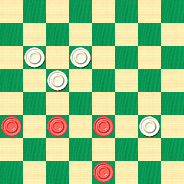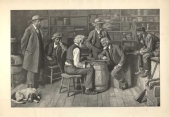The Checker Maven
The World's Most Widely Read Checkers and Draughts Publication
Bob Newell, Editor-in-Chief
Published every Saturday morning in Honolulu, Hawai`i
Noticing missing images? An explanation is here.
Cowan's Coup

When we think of a coup our image is often of one like Napoleon's coup d'etat in November, 1799, as shown above. Certainly, while a coup can be peaceful, alas, it is often anything but. So we've got to be grateful that while les coups can and do take place on the checkerboard, and they may seem rather violent in a checkeristic fashion, nothing is lost except a few pieces of wood or plastic, and even those return alive and well for the next game.
Willie Ryan, in his book Tricks Traps & Shots of the Checkerboard, shows us many a coup. Today, he'll demonstrate one associated with a Mr. Cowan. Let's take a look.

| 9-14 | 7-11 | 2-7 |
| 22-18 | 25-22 | 30-26 |
| 5-9 | 10-15 | 7-14 |
| 24-19 | 19-10 | 26-23 |
| 11-15 | 6-15 | 3-7 |
| 18-11 | 27-24 | 24-20 |
| 8-24 | 16-20 | 7-10---1 |
| 28-19 | 23-19 | 32-28 |
| 4-8 | 20-27 | 1-5 |
| 25-22 | 19-10 | 22-18 |
| 8-11 | 14-23 | 5-9 |
| 22-18 | 26-19 | 28-24 |
| 11—16 | 9-13* | 13—17---A,2 |
| 29-25 | 31-24 | Now you have |
| reproduced the diagram. |

WHITE
White to Play and Draw
W:W24,23,21,20,19,18:B17,14,12,11,10,9.
A---"In 1882, a noted player by the name of M. Cowan, of Whitehaven, England, published the position on the above diagram as a problem. In 1894, Fred S. Hogue, of San Francisco, published the above game, showing how Cowan's "landing" came up in actual play. When Hogue's opponent, playing white, reached the diagrammed setting, he resigned, believing his position hopeless. Suffice it to say that Cowan's Coup may be brought up in play from many different openings. Accordingly, every student of the game must train himself to recognize or anticipate it when it looms on the board."
1---Just about straight "book" play up to this point, where the KingsRow book ends and calls the position dead even---Ed.
2---Pretty much flawless play on both sides. Black appears to have an advantage, but it's an illusion, as the solution will show---Ed.
Will you be overthrown by this problem, or can you carry out the coup? When you've worked out the answers, click on Read More for the revolutionary solution.![]()
The Spring Chicken

Emma Janvier Smith was a turn-of-the-20th-century vaudeville performer who starred in productions that were famous for that era, including The Moth and the Flame and Miss Innocence; she also took on unique roles such as Girdle in The Spring Chicken. But our research, sadly, turned up no specific evidence that Ms. Janvier Smith played checkers, although we can well imagine her playing a game or two on a night when the theater was dark.
We also don't think she was related to checkerists J.D. Janvier or F. A. Smith, as Janvier was a stage name borrowed from her uncle--- her real surname was Spicer--- and Smith was her husband's name. However, she was certainly a contemporary of both Janvier and Smith. so anything is possible.
But in any case, today's Checker School lesson is about checkers, not vaudeville, though it can surely be argued that at times vaudeville-like situations arise on the checkerboard. Whether that adjective applies to either of the situations below is up to you to decide.
In the first situation, forces are even but White has one man in the "dog hole" on square 28, and the other man definitely lacks mobility.
BLACK
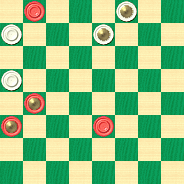
WHITE
White to Play and Draw
W:WK3,5,K7,13:B1,K17,K21,23.
The second situation is quite similar to the first, except that it's Black's move, and he has a third king instead of a second man; as we know, in checkers little things can loom large.
BLACK
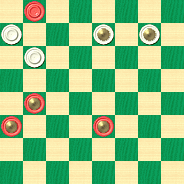
WHITE
Black to Play and Win
B:W5,K7,K8,9:B1,K17,K21,K23.
Can you solve these problems, or will you be the subject of comical failure? Either way, it's no joke that clicking your mouse on Read More will reveal the solutions, detailed notes, no less than four sample games and a supplementary problem.![]()
Clayton's Clipper

Talk about getting clipped! It seems that extreme clipping is the order of the day in the lakeside scene above. We think it may be a bit unusual to go to the lake to get clipped, although in lakeside resorts, it's inevitable that a different sort of "clip joint" is usually to be found.
A player can get clipped at the checkerboard, too, and in just as extreme a fashion. Willie Ryan, in his classic Tricks Traps & Shots of the Checkerboard, illustrates this nicely in his discussion below.

"Sometimes deadly shots exist in situations that appear so innocent that even master minds of the board will fail to detect them. The example shown here is a case in point. I had reached the situation on the diagram in one of my books, but overlooked a trim coup in my analysis. It was spotted by Jeff Clayton, the well-known Oklahoma City expert:
| 11-16 | 18-15 | 5-9---3 |
| 23-18 | 11-18 | 22-18 |
| 16-20 | 22-15 | 3-7 |
| 24-19 | 9-13---1 | 29-25 |
| 7-11---A | 25-22---2 | 7-11---B." |
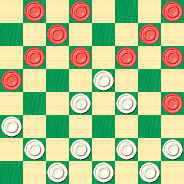
WHITE
White to Play and Win
W:W15,18,19,21,25,26,27,28,30,31,32:B1,2,4,6,8,9,10,11,12,13,20.
A---A very weak move leading to critical play, 10-14 is better.
B---Black walks into a trap with this move. There is a narrow draw here by 1-5---4, 27-23, 9-14, 18-9, 5-14, 25-22, 14-17, 21-14, 10-17, 28-24---5, 20-27, 31-24, 17-21, 23-18, 6-9, 32-27, 8-11, 15-8, 4-11, 27-23, 7-10, 24-20, 2-7, 19-16, 12-19, 23-16, 10-15,16-12, 15-19, 12-8, 7-10, 8-3, 11-16*, 20-11, 10-14, 18-15, 14-18, 15-10, 18-25, 10-6, 25-29, etc. Wm. F. Ryan."
1---8-11 is quite a bit better---Ed.
2---27-23 would have kept the edge---Ed.
3---Very weak; 8-11 would keep things on an even keel---Ed.
4---The computer disagrees and thinks this is still a probable loss. See note 5. Instead, Black should play 12-16! 19-3 10-19 3-10 6-29 27-23 9-14 23-16 29-25 etc. White still has a clear lead and a likely win, but Black's chances are a little better. It's surprising that Willie didn't look at this spectacular shot---Ed.
5---This move appears to be incorrect and gives up the win. 32-27 retains a strong White lead---Ed.
Are you going to get clipped by this problem situation, or are you able to cut it? Try to find the solution, and then slice your mouse over to Read More to see how it's done.![]()
Fourth Position

"Fourth Position" as practiced in the art of ballet is obviously very elegant, but appears a little uncomfortable to hold on to for any period of time. The ballerina above carries it out with great grace and skill, but we'll venture a guess that she might be a little tired and sore by the end of class.
Fourth Position, featured today in our ongoing Checker School series, doesn't need to be tiresome; it certainly seems easier to master than, for instance, First Position.
Or is it?
The three variants below show that there may be more here than meets the eye. Subtle changes to the position cause completely different end results. Maybe there's something to this after all!
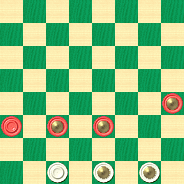
WHITE
Black to Play and Win
B:W30,K31,K32:BK20,21,K22,K23.
BLACK
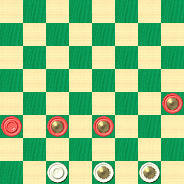
WHITE
White to Play and Draw
W:W30,K31,K32:BK20,21,K22,K23.
BLACK
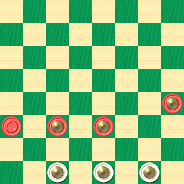
WHITE
Black to Play and Win
B:WK30,K31,K32:BK20,21,K22,K23.
In any event, it's all very practical, as four to three endings of this type come up quite often in cross-board play. Try to work out the solutions and understand why small changes make big differences. Then glide your mouse over to Read More to see the solution, sample games, and detailed explanatory notes.![]()
Priest's Pulverizer

The wicked-looking instrument in the photo above is known as a "Jackson Pulverizer" and when someone is wielding it, perhaps it is best to stand clear.
There are pulverizers in the game of checkers too, as this month's installment from Willie Ryan's Tricks Traps & Shots of the Checkerboard will clearly demonstrate, and they're no less fearsome than the steel variety. Let's see what Willie says about this.
| 10-15 | 23-18 | 8-12 |
| 21-17 | 12-16 | 27-24 |
| 6-10 | 24-20 | 3-8---B |
| 17-13 | 16-19 | 31-27 |
| 1-6 | 25-21---A | 12-16---C |

WHITE
White to Play and Win
W:W13,18,20,21,22,24,26,27,28,29,30,32:B2,4,5,6,7,8,9,10,11,15,16,19.

"Now the stage is all set for a ripping cul de sac, which American Champion Matty Priest sprung on James P. Reed in 1878.
A---If white tries 27-24, black goes 10-14, 20-16, 14-23, 24-20, 7-10*, 16-7, 2-11, 31-27, 8-12, 27-18, 19-24, 28-19, 15-24, and white's draw, if any, is problematical.
B---If black presses 10-14, white gets a winning game by 26-23---3.
C---This is where Reed took the wrong road. The following is correct to draw: 9-14, 18-9, 5-14, 22-17, 11-16, 20-11, 7-16, 29-25, 2-7, 24-20, 8-11, 27-23, 15-18, 32-27, 19-24, 28-19, 11-15, 20-2, 15-31, 2-9, 18-27, 9-18, 31-15, 17-14, 10-17, 21-14. James Lees."
3---We're not really sure where Willie was going with this, as the computer definitely thinks this line is drawn. Perhaps over the board it's difficult to play---Ed.
Can you pound your way through this position, or will you get pounded? We think you should give it a smashing good try before clicking your mouse on Read More to see the solution.![]()
Uncle Ben's Porch
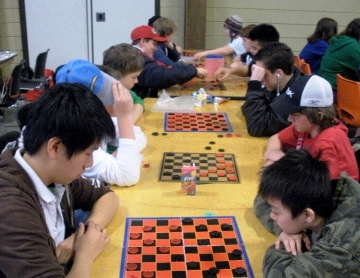
Tommy was doing well this year. Having won a spot on the varsity team in his middle school, he had moved up during the course of the year from fifth board starter--- an entry level position--- to third board starter. And now the Florida State Team Championship Tournament was coming up in just a week.

Tommy visited Uncle Ben nearly every Saturday morning, rain or shine, for his checker lesson from the kindly retired master. But Tommy was extra sure to be up on time and on his way to Uncle Ben's porch this week. He needed to be as sharp as possible for next week's tournament. Not only did he want to do his best for the school team, but how he played would determine his placement for the next school year. And taking over one of the top two slots would be no easy thing.
Uncle Ben knew about the big tournament, of course. He greeted Tommy with a smile and a bit of his usual advice. "You've done very well this year, Tommy, and I know you're wanting to do even better and get one of those higher board slots next year. But you can't think about that during the tournament. You've got to focus on each game and each move, without distracting yourself. You'll move ahead when you're ready, no sooner and no later. Coach Hovmiller will know when it's the right time.
"I've noted that you still seem to be a little impatient with some endgames. Would you agree with that?"
"Yes, sir," replied Tommy, "sometimes I just want to get the game over ..."
"Ah, Tommy, I've seen that. But it's the same thing: the game will be over when it should be, not sooner and not later, and if you try to rush things, you could lose an important couple of points for your team. So today, I want you to look at the position I've set up on the board, and take your time. Even if you think you see how it's done, I want you to spend a full five minutes thinking about all the possibilities."
Tommy agreed, but before he could turn to the board, Uncle Ben smiled and said, "Of course, a glass of lemonade will help your concentration, don't you think?" And having said this, he reached for the lemonade pitcher.

The position Tommy faced was the one shown below.
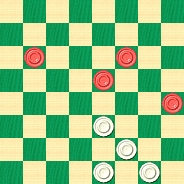
WHITE
White to Play and Win
W:W23,27,31,32:B9,11,15,20.
Tommy thought for a while, and after a couple of minutes started to say, "I've got it--- oh, wait a minute---" and went back to studying the board.
Can you solve this one yourself? Don't go for the first move that comes to mind; be patient and take the full five minutes that Uncle Ben recommends. Then click on Read More to see the solution, a sample game, and 17 additional related problems.![]()
Three Bridges

Judging by the photo above, the train is about to pull in to Three Bridges Station, and if we want to get to Chichester, we'd better get on board.
Today's entry in our Checker School series is also about three bridges, and about getting on board with their solutions if we want to ride the train to checker success. The three related bridge positions shown below are taken from Ben Boland's Famous Positions in the Game of Checkers, and knowing how to handle this very common ending type is vitally necessary, as bridge positions arise all the time in practical play. The settings are attributed to old-time players Thirkell, Keenan, and McHardy.
BLACK
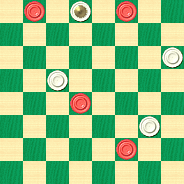
WHITE
White to Play and Draw
W:WK2,12,14,24:B1,3,18,27.
J. G. KEENAN
BLACK
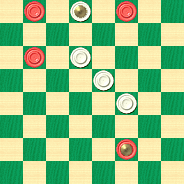
WHITE
Black Plays, White Draws
B:WK2,10,15,19:B1,3,9,K27.
A. McHARDY
BLACK
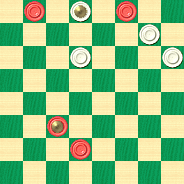
WHITE
White to Play and Draw
W:WK2,8,10,12:B1,3,K22,26.
Bridge positions can be tough to defend, and the ones above require both care and technique. Can you bridge the gap and find the drawing moves? Work out the answers and then move your mouse across the bridge to Read More to see the solutions, sample games, and detailed notes.![]()
A Bump in the Road

We get our title for today's Checker School installment from the look of the problem position.
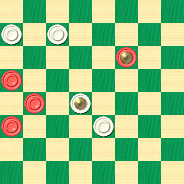
BLACK
Black to Play and Draw
B:W28,27,K15,10:BK22,20,16,12.
Black's little "bump" of three men off on the left side of the board is a formation that spells trouble, because it has no mobility, and mobility is what checkers is all about. But this bump in the road, though it's kind of a rough one, won't cause a wreck--- if you know how to handle it. There's a draw here for Black; can you find it?
Don't let this problem bump you off; solve it and then give your mouse a bump on Read More to see the solution, a sample game, and complete notes.![]()
When Wyllie Wavered

The usual definitions of wavering are (1) to move unsteadily back and forth, and (2) to exhibit irresolution or indecision. But in seeking an image to illustrate the concept of "wavering" we came across some really unusual interpretations, such as the painting above. We'll guess that maybe the boat is "wavering" on the waves? It's a pun bad enough to be worthy of The Checker Maven editoral staff! We also ran into a rock album called "Wavering Radiant"; some jewelry pieces with "wavering" patterns; and a lot more bizarre stuff that seemed at best tangentially related to the basic definitions.
Willie Ryan implies, in the excerpt below from his famous book Trips Traps & Shots of the Checkerboard that the great Wyllie "wavered" in losing in a most uncharacteristic manner. Maybe that's Willie's own definition of the word, and would be yet another to add to a growing list. But whatever you might call it, the checker play is fascinating and instructive. Willie will explain.

"James Wyllie seldom lost a game by a pitch or an unexpected shot. Those who beat him had to do it the hard way, by protracted end-game play. The following example records one of those relatively rare occasions when the canny Scot got what is commonly known as the 'Bum's Rush,' at the hands of James Mugridge of Buffalo, New York:
| 11-16 | 9-14 | 4- 8 |
| 24-20 | 18-9 | 29-25 |
| 16-19 | 5-14 | 11-15 |
| 23-16 | 25-22 | 27-24---2 |
| 12-19 | 8-11 | 8-11---3 |
| 22-18 | 22-17---1 | 32-27---A, |
| forms the | ||
| diagram. |
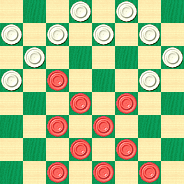
BLACK
Black to Play and Win
B:W31,30,28,27,26,25,24,21,20,17:B19,15,14,11,10,7,6,3,2,1.
A---Loses, and marks the spot where more than a few great players have fallen. The correct draw play is: 17-13, 3-8, 32-27, 15-18, 24-15, 10-19, 27-24, 7-10 (11-15, 20-16, 14-17, 21-14, 7-10, also resolves a draw), 24-15, 10-19, 26-22, 19-23, 22-15, 11-18, 20-16, 8-12, 16-11, 12-16, 11-8, 16-20, 31-26, 23-27, 26-22, 18-23, 22-18, etc. Wm. F. Ryan."
1---27-23 might be slightly better here---Ed.
2---Definitely not as good as 27-23. The computer gives Black a small edge here---Ed.
3---It took deep computer analysis to show that 1-5 may instead be the best way to retain Black's slight lead---Ed.
The solution is quite long, but don't waver for a moment. Work it through and then wave(r) your mouse over Read More to see the rest of the play.![]()

